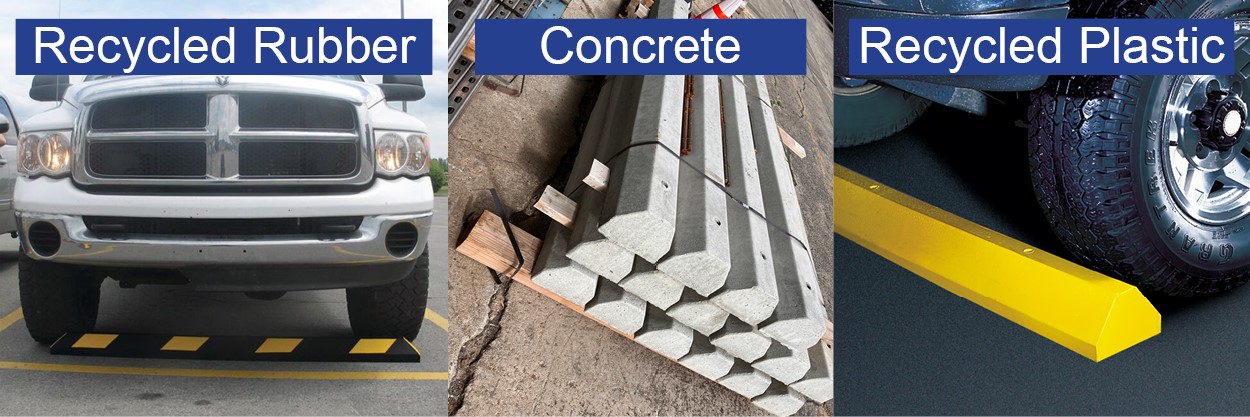
Selecting the right parking blocks (or wheel stops) for your facility, whether it's a multi-family home complex like a condominium association or a commercial facility such as a church or an office building, is essential for ensuring safety, durability, and cost-effectiveness. They are known by a variety of names, so whether you call them parking blocks, wheel stops, parking stops, curb stops, tire stoppers, car stops, or parking curbs, we can help you select the best one for your facility. As a supplier of parking blocks, I will guide you through the benefits of each material—concrete, recycled rubber, and recycled plastic—and help you determine the best choice for your needs. Because all locations are different, the ideal solution for your facility will be based on several factors we will discuss below.
Concrete Parking Blocks
Benefits:
- Durability: Concrete parking blocks are known for their strength and ability to withstand heavy loads and harsh weather conditions.
- Longevity: They have a long lifespan, making them a cost-effective option over time.
- Stability: Their weight ensures they stay in place without shifting.
- Color: You can paint the blocks to match color themes of your facility.
When to Select:
- High-Traffic Areas: Ideal for facilities with heavy vehicle traffic, such as commercial office buildings or large condominium complexes.
- Harsh Weather Conditions: Suitable for regions with extreme weather, as they can endure freezing and thawing cycles without severe damage.
- Surface is flat: Area needs to be completely flat, so the block does not shift.
- Concrete Parking Lot: The weight of concrete helps to immobile.
Recycled Rubber Parking Blocks
Benefits:
- Flexibility: Recycled rubber blocks are flexible, which helps them absorb impacts without cracking and conform to less than flat surfaces.
- Low Maintenance: They are resistant to weather, chemicals, and UV rays, requiring minimal upkeep.
- Eco-Friendly: Made from recycled materials, they contribute to sustainability efforts.
- High Visibility Design: These come with highly reflective tape in white or yellow onto black or blue recycled rubber.
- Variety of sizes: Comes in 3’, 4’ or 6’ lengths.
- Moderate Traffic Areas: Best for facilities with moderate vehicle traffic, such as smaller condominium complexes or office buildings.
- Environmental Considerations: Ideal for organizations prioritizing sustainability and reducing their carbon footprint.
- Uneven Surface: Rubber blocks can conform to the surface to accommodate parking lots that are not completely flat or a gravel lot.
- Concrete Parking Lot: The flexibility of rubber allows it to use weight and friction to reduce movement once placed.
Benefits:
- Lightweight: Easier and less expensive to install due to their lighter weight.
- Durability: Resistant to weather, chemicals, and UV rays, ensuring a long lifespan with minimal maintenance.
- Eco-Friendly: Made from recycled materials, promoting environmental sustainability.
- Colored Plastic: Never needs to be painted. They come in yellow, blue, white, and gray colors.
- Variety of sizes: Comes in 4’, 6’ or 8’ lengths.
- Light to Moderate Traffic Areas: Suitable for areas with light to moderate vehicle traffic, such as small office buildings or residential complexes.
- Cost Considerations: While they may have a higher upfront cost, their ease of installation makes it simple enough for most everyone to do it yourself for a few installs.
- Low Maintenance: These are solid plastic colored, so they do not need to be painted. They will be the same color inside when scratched or gouged.
It’s crucial to consider the type of surface these parking blocks will be installed on. Each type of parking block requires specific hardware—spikes, lag bolts, or concrete bolts—to ensure they remain securely in place. For asphalt or gravel surfaces, manufacturers recommend using spikes that are at least fourteen inches long. For asphalt or concrete surfaces, six-inch lag bolts are the preferred method of installation. If your concrete surface only allows for shallow drilling, you can use concrete bolts that require a depth of just 2.5 inches, combined with an adhesive. There are specialized adhesives available for securing parking blocks in locations where surface penetration is not possible. However, the adhesive method is not ideal, as movement can still occur despite the strength of these adhesives. In situations where drilling into the parking lot surface is prohibited by the engineer, regular maintenance may be necessary to adjust the blocks and keep them in place.
ConclusionWhen selecting the type of parking blocks for your facility, consider the specific challenges your environment presents, including traffic volume, weather conditions, budget, lot surface and sustainability goals. Concrete parking blocks are ideal for high-traffic and harsh weather conditions, recycled rubber blocks offer a balance of durability and eco-friendliness for moderate traffic areas, and recycled plastic blocks provide a lightweight, low-maintenance option for light to moderate traffic areas. If the parking area is concrete and the association does not allow you to penetrate the surface, you might consider using concrete, for its weight or rubber’s friction properties to make the blocks as immobile as possible. By evaluating these factors, you can make an informed decision that ensures safety, durability, and curb appeal for your parking areas.
By Brad TomMarketing Coordinator
G P Roadway Solutions
